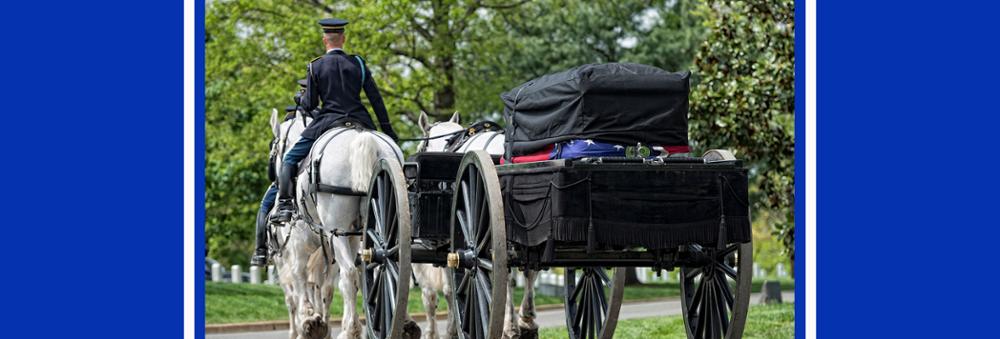(585) 352-1500

Death of a Statesman—Honoring Our Esteemed Leaders in Death
The “state funeral” is held in just about every country of the world to publicly honor deceased leaders or others of national significance, and has been an important historical convention ever since mankind first established governance. As far as historians can discern, every major civilization, as well as most of the smaller ones, established various rites and protocols to publicly honor revered leaders and other citizens of distinction upon their deaths. Similar to modern times, the state funerals of antiquity were designed to let the general populace participate in the mourning of beloved (and sometimes not so beloved) leaders and could serve as a catharsis for the people’s collective grief.
No matter the country, state funerals generally include elaborate rites, significant pomp and ceremony, and varying levels of military involvement depending upon a country’s militancy and sense of historic military tradition. Religion also usually plays a big role, though this is dependent upon the overriding faith of the country and/or faith of the leader. State funerals for leaders in most democratic countries tend to include significant religious overtones, whereas religion is completely absent from state funerals in communist countries, such as Cuba and North Korea. Certain state funeral rites and protocols—lying in state, processions, honor guards, gun salutes, appropriate music— are common to most countries. While state funerals have long drawn crowds of mourners that can reach into the hundreds of thousands, the modern era’s mass media has turned state funerals into global events that can be watched by hundreds of millions.
There have been 18 state funerals held in the U.S. since its founding, with state funerals honoring 13 presidents and five other people who received the honor by presidential designation. Sitting and former presidents, along with president-elect’s, are entitled to the honor by law. A sitting president can also bestow the honor to people outside of the presidency, though such designations have been rare. While state funerals have significant protocols, overall planning—along with the decision on whether to have a state funeral to begin with—is primarily determined by the president and his family before his death. Of the six living U.S. presidents, only former presidents Jimmy Carter and George H.W. Bush have revealed plans for state funerals. Plans for Bill Clinton, George W. Bush, Barack Obama, and sitting president Donald Trump remain unknown.
The overall planning and management of state funerals falls under the purview of the Military District of Washington (MDW), which is also in charge of combat defense of the nation’s capital region and all ceremonial operations within Arlington National Cemetery. Since the attacks of 9/11 the Department of Homeland Security has taken over responsibility for security arrangements, though MDW provides armed services to help with the security. Planning for the state funeral is dictated by a 138-page planning document, which establishes parameters for the individual presidential funeral planning. In the case of former president Carter, this has led to the filing of a 411-page document for his state funeral; while former president Bush has filed a 211-page plan for his funeral.
In general, modern state funerals in the U.S. have tended to follow similar protocols and consist of similar major components, though all are subject to adjustment. For example, sitting presidents who die while in office lie in repose in the East Room of the White House, while former presidents lie in repose in their home or adopted state prior to traveling to Washington, DC. However, former president Dwight D. Eisenhower bucked this tradition by lying in repose at the Washington National Cathedral.
Following repose, most state funerals include a ceremonial funeral procession that transports the casket from or near the White House to the U.S. Capital on a military caisson flanked by an eight-man honor guard and drawn by six horses of the same color with three riders, which are led by a section chief mounted on a separate horse. Former presidents and other honorees are transferred to the caisson at 16th and Constitution Avenues, with the procession traveling down Constitution Avenue; while the caskets of sitting presidents are traditionally placed on the caisson at the White House and make the processional journey via Pennsylvania Avenue. The funeral procession is led by a civilian police escort, which is then followed by units representing all branches of the military, with each unit including a service band. The honor guard-flanked caisson follows the military units, and is in turn followed by a riderless horse with boots reversed in the stirrup, the symbol of a fallen warrior. Former president Gerald Ford eschewed the caisson, and according to his wishes, his casket was transported by hearse, which stopped at the National World War II Memorial to pay tribute to the president’s naval service during that war.
Whether caisson or hearse, the procession is followed by a presidential motorcade that transports the family, who are usually escorted by various government dignitaries. The procession is supposed to travel at a steady three miles per hour and when halfway to the capital is honored by a 21-fighter aircraft formation that executes the “missing man” maneuver at a low enough elevation to be seen by those in or viewing the procession.
Upon arrival at the Capital the casket is carried into the Rotunda where a short service is held with the family, members of congress and sometimes other government officials. The late president’s body then lies in state with an honor guard maintaining vigil, with the public allowed through the Rotunda for viewing for at least 24 hours.
While another procession with the caisson—followed on foot by the family, government officials, hundreds of dignitaries from around the world, and the newly sworn in President Lyndon B. Jonson—was used to escort President John F. Kennedy to his national memorial service at St. Matthew’s Cathedral, most state funerals have relied on less ceremonial motorcades to transport the casket to the official service. Most services have also been held at the Washington National Cathedral, rather than other places of worship, such as St. Matthew’s.
Prior to the mid-20th century, transport of the deceased to his final resting place was generally conducted by a funeral train procession, with thousands of citizens lining the tracks throughout the states traveled through to pay their last respects. Other than President Kennedy, who was interred at Arlington National Cemetery, state funeral honorees have been transported to their final resting places via jets of the Air Force One fleet, with flight arrivals and departures accompanied by a 21-gun salute.
While this summary of the history and logistics of state funerals is certainly interesting, the emotional component and size of these services is equally, if not more, fascinating. Thus, we will take a closer look at emotion and attendance of state funerals in a future blog.
Related Links:
https://en.wikipedia.org/wiki/State_funerals_in_the_United_States
http://news.sky.com/story/an-awe-inspiring-funeral-for-a-great-statesman-10373290



Comments